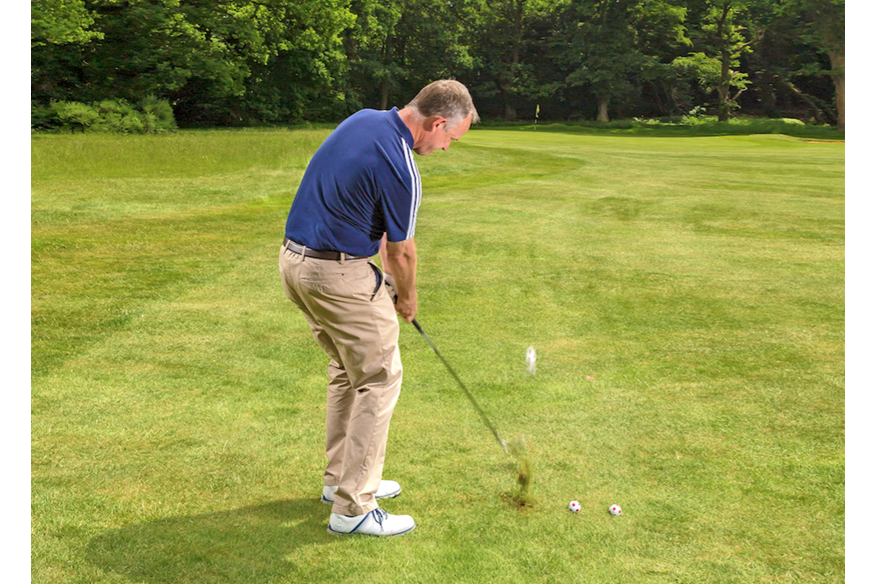How to hit a 70 yard pitch shot
Last updated:
It’s one of the fiddliest lengths in golf, but it’s a common and vital shot. There are four areas you must master to pull it off
It’s the length you often leave yourself. Whether it’s the third shot on a par 5 or long par 4, or perhaps the second on a shorter par 4, the 70-yard pitch is an in-between distance that is neither a full swing or greenside nudge. But it’s also the shot that sets up your score for the hole. For these reasons, it’s vital you have a clear picture of what you’re trying to achieve.
Sir Nick Faldo – one of the best pitchers and chippers I’ve played with – always tried to get the ball rolling on the green as soon as he could. It’s a great strategy to follow, and is your starting point for executing the 70-yarder. In doing this, there are four aspects you should consider – club selection, the lie, the swing path and spin control. Here we’ll take each and see how they can be harnessed to improve your play from 70 yards.
Pick the right club for the conditions: I’ve got three wedges here, which one I choose depends on several factors
The difference in the length of swing in these shots isn’t huge, but it’s enough for you to notice. The lob wedge is close to full, while the 52° is a three- quarter swing. The pitching wedge would be slightly less than that, but I don’t think a lot about length off swing. Instead, I focus on where I want the ball to go. A footballer doesn’t think about how far he needs to take his foot back on a particular pass. If you’re worried about distance and feel, then get out there and practise until you feel more con dent
Pitching Wedge: If I’m into a breeze and the greens are soft then I’d pick this wedge because it means I’d stand more chance of getting the ball all the way there. More loft involves more spin. When you need to bore a shot through the wind, it’s better to take spin off. With the wind in your face, it’s not a problem stopping the ball, but it is a problem getting it to the hole.
The 58 degree lob wedge: The longer you swing, the harder it is to control. The LW is a last resort for me because there’s so much loft you have to hit it hard. If it’s downwind with the pin near the front of the green, then I’ll need the spin this club provides. There’s a misconception that height stops the ball; it doesn’t – spin does. You can y it quite low with spin. Watch Thomas Bjorn, he’s a master at it.
The 52 degree wedge: I’d play this 80% of the time. I know the flight and I know it will spin and stop. It’s the control that gives this club the edge. A pitching wedge can sometimes get away from me and I can struggle to get the lob wedge all the way there. This is a happy medium. Pitch it 10 yards short, get a bounce, some check and a release. You don’t have to add loft and you don’t have to close it down.
Read the lie
All short game shots, from around the green from 100 yards out, are lie-dependent. You can’t spin a ball from a heavy lie. The moment you have to go digging for it, even slightly, then the chances of spin are reduced. The problem then is control, because a ball that doesn’t spin is going to release and run further.
When the ball is sitting up nicely (above right), you have all the options available. The lie above on the left is quite poor for control; that grass behind the ball will affect the flight and the spin. It’ll go in lower with less stop. So, you’re immediately thinking about taking a little more loft. The trouble with a PW here is that it could jump out of that lie and then I’d struggle to stop it in time. You’re digging and hitting a bit harder out of a poor lie, so more loft will compensate for that.
Get your angles right at address
As a principle for the 70-yarder, aim the face at the target, use an open stance and swing down the line of your feet. You’ll impart slight cutspin so allow for it, but you get the left hip out of the way, helping you release the club. Open the face marginally to present the ‘bounce’ to the ground.
How to maximise spin
To increase spin, move your right foot closer to the ball. This encourages a steeper attack which puts more action on the ball, making it stop faster. Keep loft on the face and let it escape across you, cutting the legs from under the ball. Note it’s harder to spin the ball from lush, grassy fairways.


